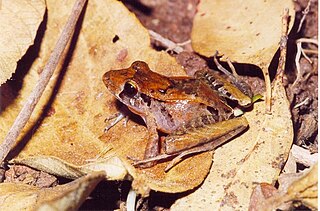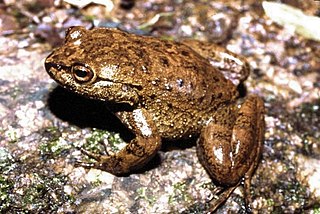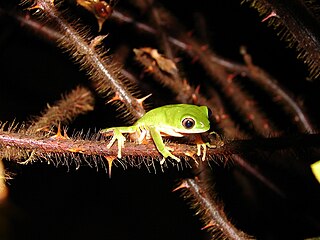
The southern frogs form the Leptodactylidae, a name that comes from Greek meaning a bird or other animal having slender toes. They are a diverse family of frogs that most likely diverged from other hyloids during the Cretaceous. The family has undergone major taxonomic revisions in recent years, including the reclassification of the former subfamily Eleutherodactylinae into its own family the Eleutherodactylidae; the Leptodactylidae now number 206 species in 13 genera distributed throughout Mexico, the Caribbean, and Central and South America. The family includes terrestrial, burrowing, aquatic, and arboreal members, inhabiting a wide range of habitats.

Pseudis is a genus of South American frogs in the family Hylidae. They are often common and frequently heard, but easily overlooked because of their camouflage and lifestyle, living in lakes, ponds, marshes and similar waters with extensive aquatic vegetation, often sitting at the surface among plants or on floating plants, but rapidly diving if disturbed. Whereas the adults are medium-sized frogs, their tadpoles are large; in some species the world's longest.

Adelophryne is a genus of frogs in the family Eleutherodactylidae. They are native to northern South America east of the Andes, known roughly from the area corresponding to the Guiana Shield, as well as to the coastal area of Bahia, Brazil. Whether the genus is truly distinct from Phyzelaphryne remains uncertain. Common name shield frogs has been proposed for this genus, although the stem flea frog is used for some species.

Ischnocnema is a genus of frogs from eastern Brazil and north-eastern Argentina. They comprise the former Eleutherodactylus from this region, but they are closer to Brachycephalus than the "true" Eleutherodactylus. Consequently, they are now placed in their own genus Ischnocnema in the family Brachycephalidae.

Physalaemus is a large genus of leptodactylid frogs. These frogs, sometimes known as dwarf frogs or foam frogs, are found in South America. It is very similar to Leptodactylus, a close relative, and indeed the recently described Leptodactylus lauramiriamae is in some aspects intermediate between them.

Adenomera is a genus of leptodactylid frogs, sometimes known as tropical bullfrogs, found in South America east of the Andes. The genus was until recently considered a synonym of Leptodactylus.

Leptodactylus is a genus of leptodactylid frogs. It includes the species commonly called ditch frogs or white-lipped frogs. It is very similar to Physalaemus, a close relative, and indeed the 2005 described Leptodactylus lauramiriamae is in some aspects intermediate between them.

Oreobates is a genus of frogs in the family Strabomantidae. Most species were formerly in the genus Ischnocnema, but were moved to this revalidated genus following a 2006 revision. Its sister taxon is Lynchius.

Bokermannohyla izecksohni, also known as Izecksohn's treefrog, is a species of frog in the family Hylidae. It is endemic to São Paulo state, Brazil. It was already considered possibly extinct in 2004, but three living frogs were discovered in 2005–2006. It is a medium-sized treefrog, measuring about 45 mm (1.8 in) in snout–vent length.
Phantasmarana bocainensis, also known as Bocaina big tooth frog is a species of frog in the family Hylodidae. It is endemic to Brazil and only known from its type locality in the Serra da Bocaina National Park, São Paulo state.

Phantasmarana boticariana is a species of frog in the family Hylodidae. It is endemic to southeastern Brazil and only known from few specimens from its type locality, Parque Estadual do Itapetinga in Atibaia, São Paulo state.
Megaelosia goeldii, also known as the Rio big-tooth frog, is a species of frog in the family Hylodidae. It is the only member of the genus Megaelosia. It is endemic to Southeast Brazil and occurs in São Paulo and Rio de Janeiro states. It is named after Émil Goeldi, a Swiss zoologist who worked in Brazil.
Phantasmarana lutzae is a species of frog in the family Hylodidae. It is endemic to Brazil and only known from its type locality in the Itatiaia National Park, Rio de Janeiro state. It is named in honor of Bertha Lutz, a Brazilian zoologist and feminist.

Proceratophrys is a genus of frogs in the family Odontophrynidae. They are found in eastern and southern Brazil, northeastern Argentina, and Paraguay, possibly into Bolivia adjacent to the Brazilian border.

Hylodidae, commonly known as giant Neotropical torrent frogs, is a family of frogs native to Brazil and northern Argentina. Phylogenetic evidence suggests the Hylodidae being the sister group to the Alsodidae.

Pithecopus is a genus of frogs in the subfamily Phyllomedusinae. Species of the genus Pithecopus are found in tropical South America east of the Andes, from southern Venezuela to northern Argentina. Resurrected from the synonymy of Phyllomedusa in 2016, it corresponds to the former Phyllomedusa hypochondrialis group. Its sister group is Callimedusa.
Pseudis platensis is a frog in the family Hylidae. It is endemic to Bolivia, Paraguay, Argentina, and Brazil.

Pithecopus araguaius is a species of frog in the family Hylidae, endemic to Brazil. It has been observed in Mato Grasso. This frog has been observed 418 meters above sea level.

Phantasmarana is a genus of frogs in the family Hylodidae. The genus is endemic to the Atlantic Forest of southeastern Brazil.
Pithecopus gonzagai is a species of frog in the family Hylidae, endemic to Brazil. It lives several states north of the Rio São Francisco.













